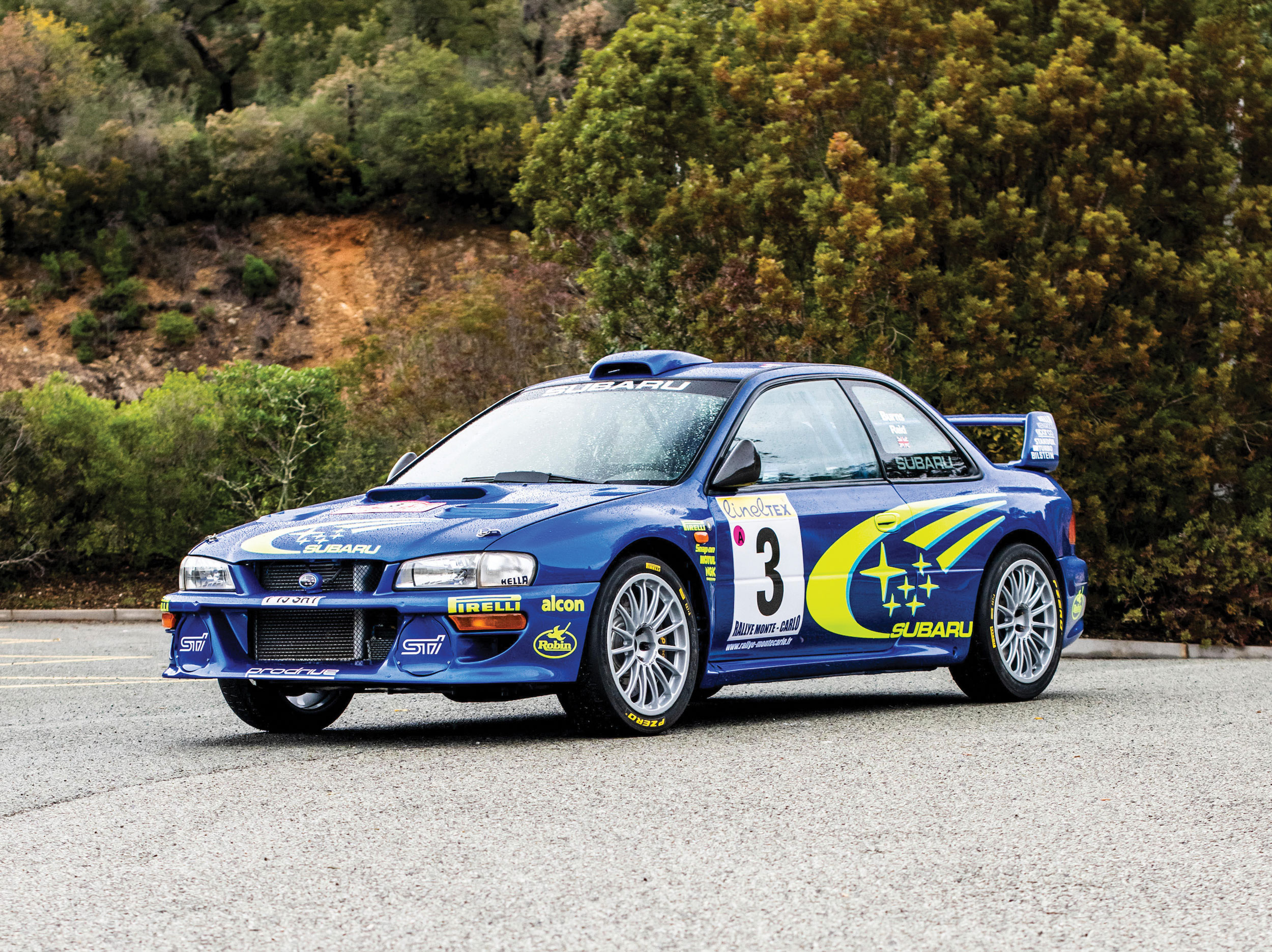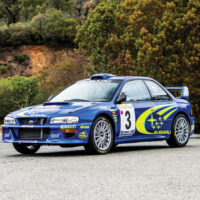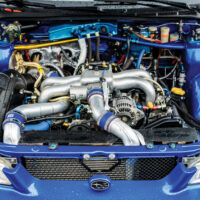This 1999 Subaru Impreza WRC99 was built to compete in the 1999-2000 World Rally Championship with the late Richard Burns. Acquired in 2018 by its current owner, whose childhood dream was to own one of the most important rally cars of its era, “T15 SRT” was in need of a complete restoration after years of competition. The work was carried out by VMS Competition, based in the South of France, a company that specializes in rally cars dating from the 1980s to the present day. Completely disassembled, the Impreza underwent extensive restoration with no expense spared, including refinishing in its 2000 Monte Carlo Rally livery. A lot of rare and original parts were found and purchased to complete the car, including carbon-fiber seats and the magnesium wheels as used in Monaco 2000. It took almost five years to complete the restoration before the engine was restarted by former Prodrive engineer Terry Stamper.
In short: What we have here is a genuine, ex-Works Subaru Impreza rally car, driven in-period by a future World Champion and certified as genuine by its constructors, Prodrive, which has had numerous modifications made in order for it to remain competitive in the course of a lengthy and varied competition career.
SCM Analysis
Detailing
| Vehicle: | 1999 Subaru Impreza WRC99 Rally Car |
| Years Produced: | 1999 |
| Number Produced: | 10 |
| Chassis Number Location: | Tag riveted to right front strut tower |
| Engine Number Location: | Etched in top rear of block |
| Club Info: | North American Subaru Impreza Owners Club |
| Website: | http://www.nasioc.com |
| Alternatives: | 1996–99 Mitsubishi Lancer Evo VI, 1999–2003 Peugeot 206 WRC, 1997–99 Toyota Corolla WRC |
This car, Lot 87, sold for $560,715 (£448,500), including buyer’s premium, at Bonhams Cars’ Chichester, U.K., sale on April 16, 2023.
Humble beginnings
Subaru entered the U.S. market in 1968 with the 360. Motivated by a 356-cc air-cooled, two-stroke, inline 2-cylinder engine, these wee machines were imported by Malcolm Bricklin through his newly formed company, Subaru of America. The tagline for the 360 was “Cheap and ugly does it” — not exactly a confidence builder. The car was panned in reviews and sold poorly. The 1970s brought a string of economically priced models to U.S. shores and introduced Subaru’s first truly iconic mantra, “Inexpensive, and built to stay that way.” Surprisingly, this approach was effective, as annual sales grew from fewer than 6,000 cars in 1970 to more than 125,000 units in 1979.
In 1980, Subaru entered the World Rally Championship (WRC) with the idea that racing victories would sell its modestly priced cars. Racing development and success came slowly for Subaru, and it was not until 1987 that its team first climbed onto the WRC podium with a 3rd-place finish in an RX Turbo at Rally New Zealand.
WRC domination
Having tasted a small morsel of WRC success, Subaru decided to go all-in. In 1989 it forged a partnership with Prodrive, which became the exclusive rally-car constructor for Subaru World Rally Team (SWRT). As time would show, this alliance forever changed the trajectory of both companies.
Subaru selected Prodrive, a British motorsports and engineering company formed by David Richards and Ian Parry in 1984, based on its prior successes. Prodrive had substantial experience building rally winners out of Porsche’s 911SC RS and BMW’s E30-series M3. Prodrive delivered some modest racing results with Subaru’s Legacy RS but, for the most part, SWRT remained an also-ran.
A major advancement occurred in 1992 with the launch of Subaru’s Impreza. The Impreza WRX (World Rally eXperimental) sport sedan featured all-wheel-drive and a front-mounted turbocharged 2.0-liter, 4-cylinder engine that could be built to produce tremendous power. Prodrive now had the raw Subaru materials to showcase its enormous talents.
According to Richard Thompson, General Manager of Prodrive Legends, “The base for the rally cars were bare body shells…based on standard road-car body shells.” Over the ensuing years, Prodrive built a series of Subaru Works rally cars including the Impreza 555, Impreza WRC97, Impreza WRC98, Impreza WRC99, and so on.
In compliance with FIA regulations, Prodrive developed rally cars for SWRT by mating a body shell to Prodrive’s own racing chassis. In turn, Subaru hired many of the greatest rally drivers of the era to pilot its Imprezas. The plan worked to perfection and, for a time, Subaru and Prodrive dominated the sport. Together they won three consecutive WRC Constructors’ Championships from 1995 to ’97 and three Drivers’ Championships in 1995, 2001 and ’03 with Colin McRae, Richard Burns and Petter Solberg. Astonishingly, the little-known Japanese company that had brought us the disparaged 360 had become one of the most dominant rally teams of all time.
Stage winner
Prodrive built a total of 22 WRC99 racers, and PR0WRC99011 represents just one of 10 examples specifically constructed for SWRT. Our subject car is a genuine Works rally car that spun its wheels in anger during WRC events in 1999 and 2000.
At the 1999 Sanremo Rally, Richard Burns raced PR0WRC99011 but failed to finish due to transmission problems. Burns raced the car again in 2000 at the Monte Carlo Rally, but after a stage win, again retired early due to ignition-system failure. Burns’ two DNFs racing PR0WRC99011 were significant. In 1999 he finished 2nd overall in the WRC Drivers’ Championship, just seven points behind Tommi Mäkinen. In 2000 he again finished 2nd overall, this time only five points back of Marcus Grönholm. These DNFs undoubtedly contributed to Burns’ painful near misses for the 1999 and 2000 WRC Drivers’ Championships.
This car matters
There are a great many reasons to care about a genuine Works rally car, especially a Prodrive Subaru. In short, WRC action in the 1990s was epic. Cars raced thousands of miles over multiple stages from insufferable deserts to snow-covered mountains. With lunatic spectators lining courses dangerously close to the race line, drivers flung their machines over the roughest of terrains, with four-wheel drifts at over 100 mph on the ragged edges of steep cliffs. The sights, sounds and aromas of this sport were nothing short of visceral.
Speedvision introduced WRC to North Americans through televised daily recaps and highlight segments, while print magazines ran frequent feature stories. Video games got youngsters hooked on rally, and U.S. Subaru drivers including motocross star Travis Pastrana, skateboarding icon Bucky Lasek and DC Shoes co-founder Ken Block became heroes to a generation of fans. By the time the Impreza WRX was introduced in the U.S. in 2002, a legion of loyal Subaru devotees had already assembled. Subaru WRX and WRX STi models gave enthusiasts of middle-class means the chance to put a rally champion in their garage. This wasn’t only about fantasy. The cars were incredibly well engineered, nimble, quick, and a total blast to drive, all at a reasonable price.
Inexpensive no more
Today, Subaru dealerships are still stocked with cars that average Americans can afford. But there is also a growing number of six-figure Subarus in the collector-car world. If you haven’t been paying close attention, you may have missed it. A recent flurry of interest in the limited-production U.S.-spec 2019 WRX STi S209 has pushed prices past the $100,000 mark from a $65k MSRP. Meanwhile, the nicest examples of the 1998 Impreza 22B STi homologation special have now topped $300k. Prodrive recently built 25 examples of the P25, a 400-hp missile paying homage to the great Subaru WRC cars. The list price was $565,000 and the cars sold out at turbocharged speed. These are all road cars, not race cars, and they demonstrate the tremendous interest in the Subaru marque among Gen X collectors.
When it comes to race cars, the supply of genuine Works WRC examples is limited. Our subject car has been fully verified and documented by its builder, Prodrive. According to Matthew French, Operations Controller at Prodrive Legends, “The chassis is correct as from Prodrive, although it’s been restored recently by a specialist. The engine number on the cylinder block is not a Prodrive number and not original to the car.”
While this car has a lot going for it — it was raced by rally legend Richard Burns — the non-original engine is notable. More important is that its historical significance is limited to being a WRC stage winner, not a race winner. Yet despite this lack of resume, our subject car sold at a price that tops all other Subaru rally cars from this era that have recently sold publicly. Well sold.



